< Collection search
< Collection highlights
From:UC Teece Museum of Classical Antiquities
Name/TitlePlaster Cast Head of the goddess Hygeia from Epidauros
About this objectThis plaster cast of the head of the goddess Hygeia is based on a Roman copy of a Greek original. Hygeia displays a calm expression and straight profile associated with the Classical sculpture of the fifth century. However, the slightly plate-like eyelids and the angular treatment of the eyebrows and bridge of the nose as a continuous line recalls the earlier Severe style. Her hairstyle with thick wavy hair loosely gathered at the top of the head in a knot, is not seen prior to the fourth century. The date of the Roman copy (from which this cast is made) is unknown and a date is difficult to identity in part because we do not know what variations to the original, if any, the Roman copyist might have introduced.
The original head was found in the sanctuary of Asclepius at Epidauros, one of the most important sanctuaries to this god in Antiquity. Asclepius was a god associated with healing, as were his father Apollo and his aunt Artemis. People enlisted the help of these gods by visiting their sanctuaries, which were often located at a natural spring. Statues of deities and miniature clay models of body parts are frequently found at sanctuaries of Asclepius, the majority of which were offerings of thanks to the god for a cure. The original statue this head belonged to may have been given in gratitude for the a cure of an illness or injury.
Hygeia was one of many children of Asclepius and was the goddess of hygiene and cleanliness. The identification of this head as the goddess Hygeia is inferred in part from the context in which she was found within the sanctuary. Hygeia is usually represented as a maiden, and is often shown wearing a fillet (headband) or diadem, or with her hair styled in a way to suggest one, as with this example. The double-looped knot of hair seen here is also found on other statues of the goddess in which she is shown holding a snake. The snake helps to identify statues of Hygeia as it is also an attribute of Asclepius.
MakerMinistry of Culture Archaeological Receipts Fund
Maker RoleCasting and Copying Workshop
Date Madeca. 1988-1989
Place MadeGreece; Athens
Medium and MaterialsPlaster
Style and IconographyRoman
TechniqueCasting (process)
Measurements180mm x 120mm x 100mm
Subject and Association KeywordsGoddesses in art
Subject and Association KeywordsWomen in art
Subject and Association KeywordsArt and religion
Named CollectionThe James Logie Memorial Collection, University of Canterbury, New Zealand
Credit LinePurchased, 1996.
Object TypeSculpture
Object numberCC28
Copyright LicenceAll rights reserved


